Land and Natural Resource Redistribution in Zimbabwe Access, Equity and Conflict.【外文翻译】
初中英语作文保护土地资源
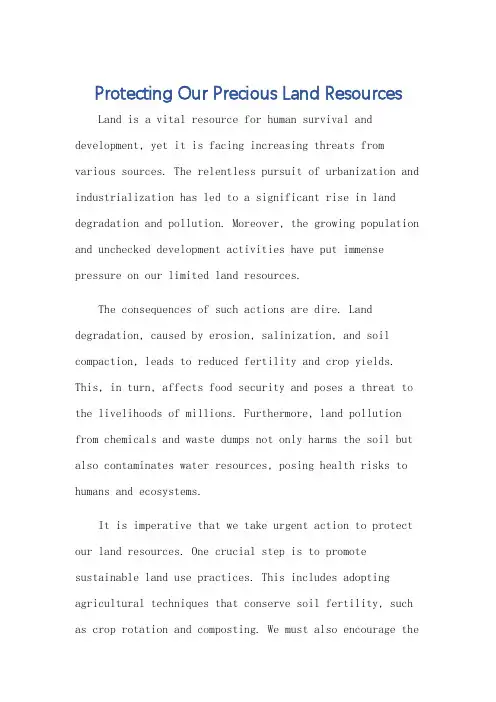
Protecting Our Precious Land ResourcesLand is a vital resource for human survival and development, yet it is facing increasing threats from various sources. The relentless pursuit of urbanization and industrialization has led to a significant rise in land degradation and pollution. Moreover, the growing population and unchecked development activities have put immense pressure on our limited land resources.The consequences of such actions are dire. Land degradation, caused by erosion, salinization, and soil compaction, leads to reduced fertility and crop yields. This, in turn, affects food security and poses a threat to the livelihoods of millions. Furthermore, land pollution from chemicals and waste dumps not only harms the soil but also contaminates water resources, posing health risks to humans and ecosystems.It is imperative that we take urgent action to protect our land resources. One crucial step is to promote sustainable land use practices. This includes adopting agricultural techniques that conserve soil fertility, such as crop rotation and composting. We must also encourage theuse of renewable energy sources and promote eco-friendly building materials to reduce the demand for land resources. Moreover, it is essential to strengthen land protection policies and regulations. Governments must enforce strict land use planning and ensure that development activities adhere to sustainable standards. Additionally, awareness-raising campaigns and educational programs should be conducted to educate the public about the importance of land conservation and the need for sustainable development. In conclusion, protecting our land resources is a crucial task that requires the collective effort of all. By adopting sustainable practices, enforcing policies, and raising awareness, we can ensure the preservation of our precious land for future generations.**保护珍贵的土地资源**土地是人类生存与发展的宝贵资源,然而,它正面临着来自各方面的日益严重的威胁。
保护自然资源NaturalResources-英语作文
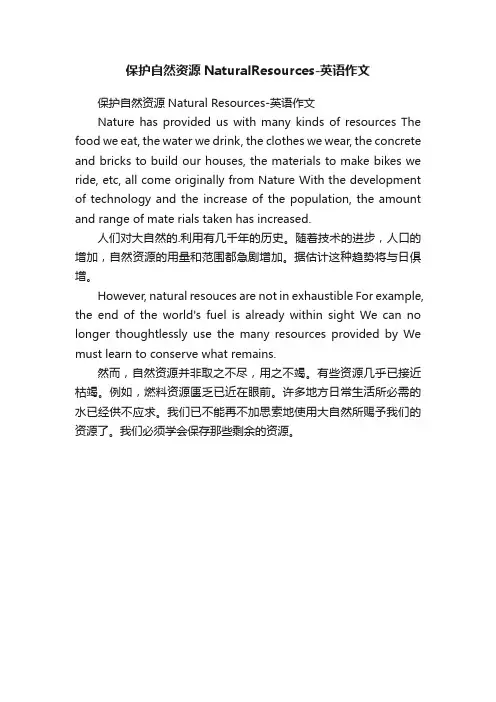
保护自然资源NaturalResources-英语作文保护自然资源Natural Resources-英语作文Nature has provided us with many kinds of resources The food we eat, the water we drink, the clothes we wear, the concrete and bricks to build our houses, the materials to make bikes we ride, etc, all come originally from Nature With the development of technology and the increase of the population, the amount and range of mate rials taken has increased.人们对大自然的.利用有几千年的历史。
随着技术的进步,人口的增加,自然资源的用量和范围都急剧增加。
据估计这种趋势将与日俱增。
However, natural resouces are not in exhaustible For example, the end of the world's fuel is already within sight We can no longer thoughtlessly use the many resources provided by We must learn to conserve what remains.然而,自然资源并非取之不尽,用之不竭。
有些资源几乎已接近枯竭。
例如,燃料资源匮乏已近在眼前。
许多地方日常生活所必需的水已经供不应求。
我们已不能再不加思索地使用大自然所赐予我们的资源了。
我们必须学会保存那些剩余的资源。
外文翻译--Land and Natural Resource Redistribution
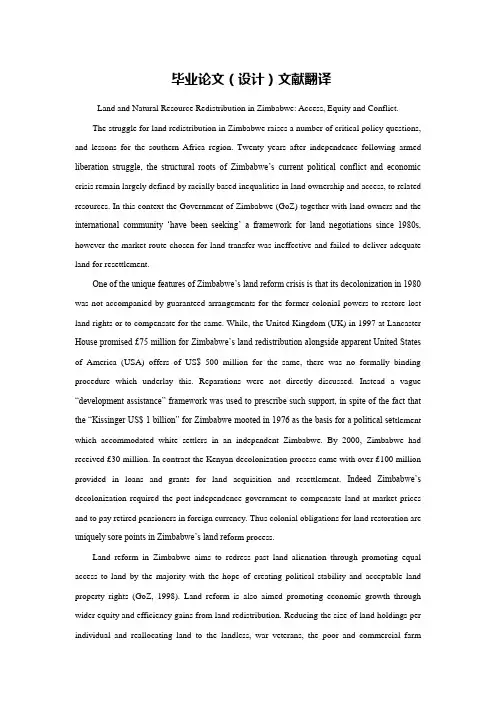
毕业论文(设计)文献翻译Land and Natural Resource Redistribution in Zimbabwe: Access, Equity and Conflict.The struggle for land redistribution in Zimbabwe raises a number of critical policy questions, and lessons for the southern Africa region. Twenty years after independence following armed liberation struggle, the structural roots of Zimbabwe’s current political conflict and economic crisis remain largely defined by racially based inequalities in land ownership and access, to related resources. In this context the Government of Zimbabwe (GoZ) together with land owners and the international community ‘have been seeking’ a framework for land negotiations since 1980s, however the market route chosen for land transfer was ineffective and failed to deliver adequate land for resettlement.One of the unique features of Zimbabwe’s land reform crisis is that its decolonization in 1980 was not accompanied by guaranteed arrangements for the former colonial powers to restore lost land rights or to compensate for the same. While, the United Kingdom (UK) in 1997 at Lancaster House promised £75 million for Zimbabwe’s land redistribution alongside apparent United States of America (USA) offers of US$ 500 million for the same, there was no formally binding procedure which underlay this. Reparations were not directly discussed. Instead a vague “development assistance” framework was used to prescribe such support, in spite of the fact that the “Kissinger US$ 1 billion” for Zimbabwe mooted in 1976 as the basis for a political set tlement which accommodated white settlers in an independent Zimbabwe. By 2000, Zimbabwe had received £30 million. In contrast the Kenyan decolonization process came with over £100 million provided in loans and grants for land acquisition and resettlement. Indeed Zimbabwe’s decolonization required the post-independence government to compensate land at market prices and to pay retired pensioners in foreign currency. Thus colonial obligations for land restoration are uniquely sore points in Zimbabwe’s land ref orm process.Land reform in Zimbabwe aims to redress past land alienation through promoting equal access to land by the majority with the hope of creating political stability and acceptable land property rights (GoZ, 1998). Land reform is also aimed promoting economic growth through wider equity and efficiency gains from land redistribution. Reducing the size of land holdings per individual and reallocating land to the landless, war veterans, the poor and commercial farmworkers also aims to promote national self-sufficiency, food security and agricultural development through labor intensive small farmer production and optimal land productivity and returns to capital invested.In Zimbabwe the power relations and the structures that have developed over a long time on the land question have been the major foci on which conflicts over land have evolved. In most cases land reforms have to, and almost axiomatically, entail major confrontations between different powers. The paper illustrates that, in spite of trying persuasion and all sorts of negotiated forms, of land acquisition the driving process has been some kind of confrontation. In terms of the international experience, in 30 or so countries in which there’s been land reform, from Japan to Chile, in Europe and even in Africa (Algeria and Kenya, and South Africa), there is hardly any country where there has been some kind of a pure market land reform or land reform based on full compensation on the market for land acquired. It has never happened anywhere else, except in Zimbabwe, and this is the issue that the paper emphasizes. The Zimbabweans, the South Africans, and the Namibians are debating a particular kind of market land reform that has rarely been feasible historically and that is politically problematic to implement and morally difficult to justify.For two decades mostly the market has governed the government strategy on land acquisition for redistribution. The GoZ used persuasion and force to restrain communities from spontaneous action to repossess their land rights. Instead government took responsibility for gradually acquiring land from the market and redistributing it to the needy and “competent”. The land acquisition policy is thus not based upon legal restitution of particular private or community land rights which had been expropriated during colonial rule. The postcolonial state did not affirm its sovereign right over land by for instance nationalizing it. However, Zimbabwe has experienced 3 broadly interactive approaches to land acquisition, namely: market land acquisition led by the state; state-led compulsory land acquisitions with full compensation or compensation only for improvements, and attempted land seizures through land occupations.This paper reviews Zimbabwe’s experi ence in land acquisition for resettlement since 1980. Although land reform and redistribution entails a variety of aspects such as land use planning, beneficiary selection; land settlement; infrastructure development, farming support system, and training, and financing the resettlement, the most volatile politics of land reform hover aroundland transfers. Public acquisition of land for redistribution is central to the history of land reform because state-led challenges to unequal private property relations have evolved over time alongside popular community actions (legal or ‘illegal’) to redress historical injustices in land ownership. After all the sustainability of any structure of property relations depends on its political acceptability in terms of equity and the respect of institutions that protect such rights. Restructuring land ownership patterns, quite apart from the subsequent use of land, is the starting point in land and agrarian reforms.The land question in Zimbabwe has also been examined in terms of the simultaneous execution of both land reform and agrarian reform. Agrarian reform presumes changing land property relations towards more equitable access to productive land (Moyo, 1999). The GoZ has in the last twenty years pursued agrarian reforms of a largely market oriented genre (Moyo, 2000) focusing on various agricultural marketing, extension and other policy reforms, tax incentives, financial re-organisation and institutional reforms (Rukuni and Eicher, 1996). Such reforms have however benefited mainly the current white large-scale landowners. The economic structural adjustment policy (ESAP) for instance offered little concrete resources to black smallholder export-led growth in commodity production, due to the restrictive land, water and infrastructural conditions of communal areas.Using a political economy perspective this paper examines key policy processes and political confrontations, which structure the acquisition of land for land reform in Zimbabwe. The major social and political contradictions and contestations, as well as social processes involved in land acquisition and restructuring land rights in terms of who leads and benefits are discussed in the context of changing institutional processes, including international capital and donors (Moyo, 1999). Heuristically, the empirical analyses followed addresses both macro-level and micro-level processes of the land acquisition. The paper questions whether land acquisition processes have been equators in terms of the quality of land and the nature of land rights extinguished, and how international interests converge or diverge with national interests that shape land reform.Moyo,Sam, "Land and Natural Resource Redistribution in Zimbabwe: Access, Equity and Conflict", African and Asian Studies, 2005, vol.4, No.1-2在津巴布韦的土地重新分配的斗争提出了若干重要政策问题,为南部非洲地区和教训。
自然和文化资源英语作文
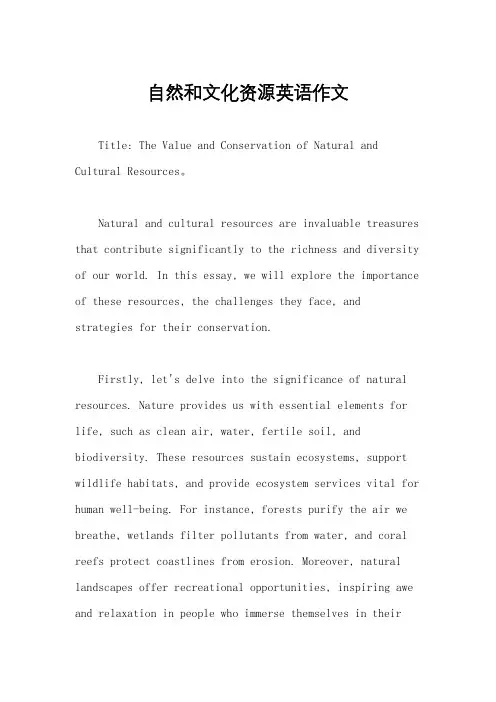
自然和文化资源英语作文Title: The Value and Conservation of Natural and Cultural Resources。
Natural and cultural resources are invaluable treasures that contribute significantly to the richness and diversity of our world. In this essay, we will explore the importance of these resources, the challenges they face, andstrategies for their conservation.Firstly, let's delve into the significance of natural resources. Nature provides us with essential elements for life, such as clean air, water, fertile soil, and biodiversity. These resources sustain ecosystems, support wildlife habitats, and provide ecosystem services vital for human well-being. For instance, forests purify the air we breathe, wetlands filter pollutants from water, and coral reefs protect coastlines from erosion. Moreover, natural landscapes offer recreational opportunities, inspiring awe and relaxation in people who immerse themselves in theirbeauty.Cultural resources, on the other hand, encompasstangible and intangible heritage passed down through generations. They include historical sites, monuments, artifacts, traditional knowledge, languages, and customs. These resources connect us to our past, fostering a senseof identity, belonging, and continuity. They also serve as educational tools, allowing us to learn from history and diverse cultural perspectives. Preserving cultural heritage not only honors our ancestors' achievements but also enriches contemporary society with cultural diversity and creativity.Despite their importance, both natural and cultural resources face numerous threats. Human activities such as deforestation, pollution, urbanization, andoverexploitation degrade natural environments and threaten biodiversity. Climate change exacerbates these challenges, altering ecosystems and exacerbating extreme weather events. Similarly, cultural resources are vulnerable to neglect, vandalism, armed conflict, urban development, andglobalization. Economic pressures often prioritize short-term gains over long-term sustainability, leading to the destruction of irreplaceable cultural and natural treasures.To address these challenges, effective conservation strategies are imperative. For natural resources, conservation efforts should focus on habitat restoration, sustainable land management, biodiversity protection, and climate change mitigation. Encouraging sustainablepractices such as organic farming, renewable energy adoption, and responsible tourism can reduce environmental impacts while promoting economic development. Additionally, establishing protected areas, wildlife corridors, andmarine reserves safeguard critical habitats andbiodiversity hotspots.Similarly, preserving cultural resources requires collaborative efforts involving communities, governments, NGOs, and international organizations. Conservationinitiatives should include documentation, research, restoration, and public education programs. Engaging local communities in heritage preservation empowers them asstewards of their cultural legacy, fostering pride and ownership. Furthermore, promoting cultural tourism and sustainable development initiatives can generate economic benefits while conserving heritage sites and traditions.In conclusion, natural and cultural resources are invaluable assets that enrich our lives in myriad ways. However, they face significant threats due to human activities and environmental degradation. To ensure their preservation for future generations, concerted efforts are needed to implement sustainable practices and conservation measures. By valuing and protecting these resources, we can create a more resilient and harmonious world for all living beings.。
初中英语作文保护土地资源
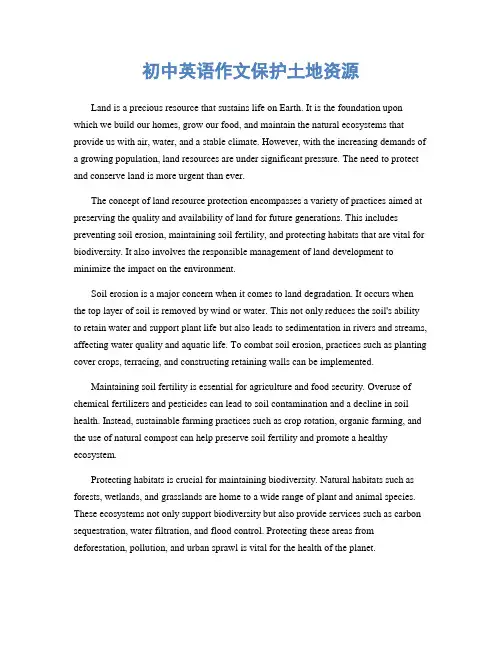
初中英语作文保护土地资源Land is a precious resource that sustains life on Earth. It is the foundation upon which we build our homes, grow our food, and maintain the natural ecosystems that provide us with air, water, and a stable climate. However, with the increasing demands of a growing population, land resources are under significant pressure. The need to protect and conserve land is more urgent than ever.The concept of land resource protection encompasses a variety of practices aimed at preserving the quality and availability of land for future generations. This includes preventing soil erosion, maintaining soil fertility, and protecting habitats that are vital for biodiversity. It also involves the responsible management of land development to minimize the impact on the environment.Soil erosion is a major concern when it comes to land degradation. It occurs when the top layer of soil is removed by wind or water. This not only reduces the soil's ability to retain water and support plant life but also leads to sedimentation in rivers and streams, affecting water quality and aquatic life. To combat soil erosion, practices such as planting cover crops, terracing, and constructing retaining walls can be implemented.Maintaining soil fertility is essential for agriculture and food security. Overuse of chemical fertilizers and pesticides can lead to soil contamination and a decline in soil health. Instead, sustainable farming practices such as crop rotation, organic farming, and the use of natural compost can help preserve soil fertility and promote a healthy ecosystem.Protecting habitats is crucial for maintaining biodiversity. Natural habitats such as forests, wetlands, and grasslands are home to a wide range of plant and animal species. These ecosystems not only support biodiversity but also provide services such as carbon sequestration, water filtration, and flood control. Protecting these areas from deforestation, pollution, and urban sprawl is vital for the health of the planet.Responsible land development is key to balancing human needs with environmental protection. This involves careful planning to ensure that new developments are sustainable and do not encroach on important natural areas. Smart growth strategies, such as building up rather than out, can help reduce the footprint of urban expansion and preserve open spaces.Education and awareness are also important components of land resource protection. By educating the public about the importance of land conservation and the steps they can take to help, we can foster a culture of stewardship that values and protects our natural resources.In conclusion, protecting land resources is a complex task that requires the cooperation of individuals, communities, and governments. Through sustainable practices, responsible development, and education, we can ensure that our land remains a viable and vibrant resource for generations to come. It is our collective responsibility to care for the Earth and safeguard its resources, for the land is not just the ground beneath our feet; it is the very foundation of life itself. 。
自然资源作文英文
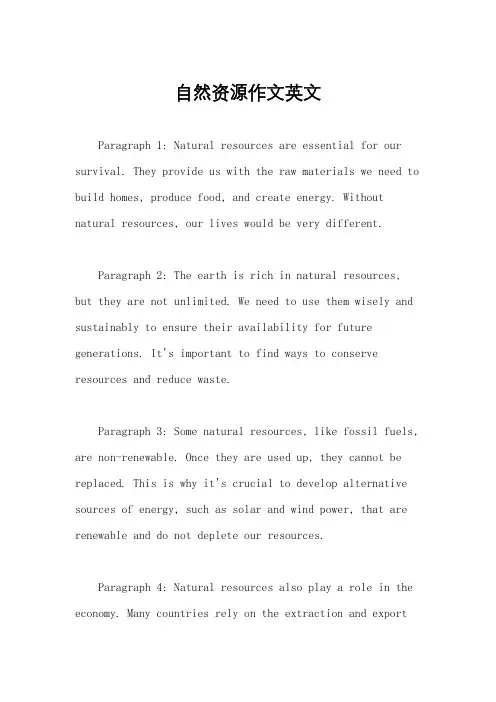
自然资源作文英文Paragraph 1: Natural resources are essential for our survival. They provide us with the raw materials we need to build homes, produce food, and create energy. Without natural resources, our lives would be very different.Paragraph 2: The earth is rich in natural resources, but they are not unlimited. We need to use them wisely and sustainably to ensure their availability for future generations. It's important to find ways to conserve resources and reduce waste.Paragraph 3: Some natural resources, like fossil fuels, are non-renewable. Once they are used up, they cannot be replaced. This is why it's crucial to develop alternative sources of energy, such as solar and wind power, that are renewable and do not deplete our resources.Paragraph 4: Natural resources also play a role in the economy. Many countries rely on the extraction and exportof resources like oil, minerals, and timber to generate income. However, this can also lead to environmental degradation and social issues if not managed properly.Paragraph 5: The exploitation of natural resources can have negative impacts on the environment. Deforestation,for example, not only destroys habitats but alsocontributes to climate change. It's important to find a balance between economic development and environmental protection.Paragraph 6: In addition to their practical uses, natural resources also have cultural and aesthetic value. They provide inspiration for art, literature, and music. Many people find solace and connection in nature, which is why it's important to preserve and protect these resources.Paragraph 7: The responsibility to protect natural resources falls on all of us. We can make a difference by practicing sustainable living, reducing our consumption, and supporting initiatives that promote conservation and environmental stewardship.Paragraph 8: In conclusion, natural resources are vital for our survival and well-being. We must recognize their value and take action to ensure their sustainable use. By doing so, we can create a better future for ourselves and future generations.。
尊重自然,珍惜资源
尊重自然,珍惜资源Respect Nature and Cherish Resources Nature, the mother of all creatures, is a bounty bestowed upon us by the universe. She endows us with lush forests, clear rivers, fertile soil, and diverse wildlife - resources that are essential for our survival and well-being. However, as humanity marches forward in its relentless pursuit of progress and development, we often forget to show gratitude towards this bountiful gift from nature. We squander her resources without restraint, ignoring the consequences of our actions on both ourselves and the environment.The time has come for us to wake up and realize the importance of respecting nature and cherishing her resources. We must remember that every drop of water, every breath of air, and every morsel of food comes from nature's generous bosom. It is not ours to waste or destroy but rather something we should protect and preserve for future generations. By wasting natural resources, we not only deprive others of their share but also imperil the existence of countless species who call this planet home. Moreover, disrespecting nature can lead to catastrophic consequences such as climate change, environmental degradation, and biodiversity loss. These issues threaten not just individual lives but also the stability and sustainability of our entire society. Therefore, it becomes imperative for each one of us to adopt eco-friendlypractices and make concerted efforts to conserve natural resources. Simple steps like reducing energy consumption, recycling materials, planting more trees, and preserving wildlife habitats can go a long way in protecting our precious natural heritage.In conclusion, respecting nature and cherishing her resources is an obligation that rests squarely on our shoulders. Let us rise to this challenge, embrace sustainability, and ensure that future generations inherit a healthy and vibrant planet where they can thrive and prosper together with all other forms of life.。
自然资源的枯竭英语作文
自然资源的枯竭英语作文Natural resources are depleting at an alarming rate. The excessive exploitation of forests, water, minerals, and fossil fuels has led to the depletion of these resources. It is a serious problem that needs to be addressed immediately.Forests are being cut down at an unprecedented rate. The demand for timber, paper, and land for agriculture and urban development has led to massive deforestation. This not only destroys the habitat of countless species but also contributes to climate change.Water is another natural resource that is being depleted. The overuse of water for agriculture, industry, and domestic purposes has led to water scarcity in many parts of the world. This has serious implications for food security and human health.Minerals such as coal, oil, and natural gas are finiteresources that are being rapidly depleted. These resources are essential for energy production, transportation, and manufacturing. As they become scarcer, the cost of extracting them will increase, leading to higher prices for consumers.Fossil fuels, such as coal, oil, and natural gas, are also being depleted. These non-renewable resources are the primary source of energy for the world. As they become scarcer, the cost of energy will increase, leading to higher prices for consumers and businesses.The depletion of natural resources has serious consequences for the environment and human society. It is essential that we find sustainable alternatives to meet our needs without depleting the Earth's resources. Otherwise, we will face a future of scarcity and environmental degradation.。
保护自然资源英语作文
保护自然资源英语作文In the modern era, where industrialization and urbanizationare progressing at an unprecedented pace, the importance of protecting our natural resources has become more criticalthan ever. Natural resources are the foundation of life on Earth, providing essential elements such as water, air, and fertile soil, which are vital for the sustenance of allliving organisms. This essay will explore the significance of conserving these resources and suggest ways in which we can contribute to this global effort.Firstly, it is crucial to understand the concept of natural resources. They include renewable resources like sunlight, wind, and rain, as well as non-renewable resources such as minerals, fossil fuels, and metals. The overexploitation of these resources, particularly the non-renewable ones, has led to a significant decline in their availability, posing athreat to the ecological balance and the future of our planet.The consequences of not conserving our natural resources are dire. Climate change, loss of biodiversity, deforestation,and water scarcity are just a few of the many issues thatarise from unsustainable practices. These not only affect the environment but also have a direct impact on human health and the global economy.To mitigate these issues, several measures can be taken atboth the individual and collective levels. Here are somestrategies that can help in conserving natural resources:1. Reduce, Reuse, Recycle: This mantra should be at the forefront of our daily lives. By reducing waste, reusing items, and recycling materials, we can significantly decrease the demand for new resources.2. Sustainable Agriculture: Adopting sustainable farming practices can help preserve soil quality and prevent water pollution. This includes using organic fertilizers, crop rotation, and avoiding monoculture.3. Energy Efficiency: Using energy-efficient appliances and lighting can reduce the consumption of electricity, which often comes from non-renewable sources like coal and oil.4. Renewable Energy: Investing in and using renewable energy sources like solar, wind, and hydro power can help decrease our reliance on fossil fuels.5. Afforestation: Planting more trees and preserving existing forests not only helps in absorbing carbon dioxide but also maintains the water cycle and provides habitat for countless species.6. Education and Awareness: Educating the public about the importance of natural resources and how to conserve them is vital. This can be achieved through school programs, community workshops, and media campaigns.7. Policy and Regulation: Governments play a crucial role inenacting policies that protect natural resources and promote sustainable practices. This includes regulating industrial emissions, enforcing fishing quotas, and protecting natural habitats.8. Support Sustainable Products: As consumers, we have the power to influence the market by choosing products that are made sustainably and support companies that prioritize the environment.In conclusion, the conservation of natural resources is not just an environmental issue; it is a moral and economic one as well. It requires a collective effort from all sectors of society, from individuals to governments and international organizations. By taking proactive steps to protect and preserve our natural resources, we can ensure a sustainable future for generations to come.。
Natural resources石油森林和淡水自然资源以惊人的速度被消耗这会造成什么问题 英语作文
The natural resources such as oil, forests and fresh water are being consumed at an alarming rate. What problems does it cause?How can we solve these problems?Give reasons for your answer and include any relevant examples from your own knowledge or experience. Write at least 250 words.Model Answer:With the ever increasing population in the world and rapid industrial growth, we are facing a thorny issue in these days and the time has come for us to address it properly in order to ensure our very existence. The consumption of oil, trees and fresh water is ever growing andthough those resources are quite limited and non-renewable in many cases, we have taken very few steps to prevent the overuse of those invaluable resources. As a result, catastrophic outcomes are obvious and we should take every possible measure to solve these problems.First, reservation of oil and fresh water is not limitless and over consumption of these two resources will cause scarcity of natural resources. When the oil reservation will go down, nations will fight over it and factories, machines and cars will be useless without oil. Moreover, the overuse of oil causes uncontrollable airpollution and catastrophic effects like, the global warming and climate change which threaten our very existence on the earth. Fresh water is another big area of concern as it is a critical issue for the living organism and less than 3% water reservation on the earth is fresh water. Freshwater resources are depleting fast and this will cause our living on the earth impossible.Undoubtedly deforestation is the reason many species are becoming extinct and our environment is getting polluted. As most countries are trying to improve their economic conditions through industrialisation, we areimposing an unbearable burden to the natural ecosystem by consuming importation natural resources. This increasing rate of natural resources consumption causes scarcity of natural resources, burdens to the ecosystem, air pollution, water pollution, soil erosion, natural unbalance, extinction of many species, water contamination, an outbreak of diseases and finally threaten our existence.All nations and every individual should put their best effort to combat this problem. It is a global issue and hence should be addressed globally. Moreover, every government should ensureadequate legislations and strict laws to prevent the over-consumption of important natural resources. Factories, mills and industries should not be allowed to contaminate waters and should be severely fined if found guilty. Ownership of cars should be restricted and prices of oil should be increased. Strict monitoring of logging activity should be in place and plantation of trees should be encouraged. Along with government’s initiatives, individual effort to address this problem should also be in place. We should use water conservatively and use our car less. Gardening and plantation should be a mandatory part of building a newhouse. The individual effort on saving our planet and future generation will play a key role in addressing these problems. Finally, more research works are required to introduce better water recycling machines, eco-friendly vehicles and alternative sources of energy.In conclusion, I would reiterate that important natural resources like water, oil, trees should not be exploited and individual and government initiatives can reduce the problems caused by it to a great extent. If we fail to do that, the consequence would be too severe to control.。
- 1、下载文档前请自行甄别文档内容的完整性,平台不提供额外的编辑、内容补充、找答案等附加服务。
- 2、"仅部分预览"的文档,不可在线预览部分如存在完整性等问题,可反馈申请退款(可完整预览的文档不适用该条件!)。
- 3、如文档侵犯您的权益,请联系客服反馈,我们会尽快为您处理(人工客服工作时间:9:00-18:30)。
毕业论文(设计)文献翻译Land and Natural Resource Redistribution in Zimbabwe: Access, Equity and Conflict.The struggle for land redistribution in Zimbabwe raises a number of critical policy questions, and lessons for the southern Africa region. Twenty years after independence following armed liberation struggle, the structural roots of Zimbabwe’s current political conflict and economic crisis remain largely defined by racially based inequalities in land ownership and access, to related resources. In this context the Government of Zimbabwe (GoZ) together with land owners and the international community ‘have been seeking’ a framework for land negotiations since 1980s, however the market route chosen for land transfer was ineffective and failed to deliver adequate land for resettlement.One of the unique features of Zimbabwe’s land reform crisis is that its decolonization in 1980 was not accompanied by guaranteed arrangements for the former colonial powers to restore lost land rights or to compensate for the same. While, the United Kingdom (UK) in 1997 at Lancaster House promised £75 million for Zimbabwe’s land redistribution alongside apparent United States of America (USA) offers of US$ 500 million for the same, there was no formally binding procedure which underlay this. Reparations were not directly discussed. Instead a vague “development assistance” framework was used to prescribe such support, in spite of the fact that the “Kissinger US$ 1 billion” for Zimbabwe mooted in 1976 as the basis for a political sett lement which accommodated white settlers in an independent Zimbabwe. By 2000, Zimbabwe had received £30 million. In contrast the Kenyan decolonization process came with over £100 million provided in loans and grants for land acquisition and resettlement. I ndeed Zimbabwe’s decolonization required the post-independence government to compensate land at market prices and to pay retired pensioners in foreign currency. Thus colonial obligations for land restoration are uniquely sore points in Zimbabwe’s land refo rm process.Land reform in Zimbabwe aims to redress past land alienation through promoting equal access to land by the majority with the hope of creating political stability and acceptable land property rights (GoZ, 1998). Land reform is also aimed promoting economic growth through wider equity and efficiency gains from land redistribution. Reducing the size of land holdings per individual and reallocating land to the landless, war veterans, the poor and commercial farmworkers also aims to promote national self-sufficiency, food security and agricultural development through labor intensive small farmer production and optimal land productivity and returns to capital invested.In Zimbabwe the power relations and the structures that have developed over a long time on the land question have been the major foci on which conflicts over land have evolved. In most cases land reforms have to, and almost axiomatically, entail major confrontations between different powers. The paper illustrates that, in spite of trying persuasion and all sorts of negotiated forms, of land acquisition the driving process has been some kind of confrontation. In terms of the international experience, in 30 or so countries in which there’s been land reform, from Japan to Chile, in Europe and even in Africa (Algeria and Kenya, and South Africa), there is hardly any country where there has been some kind of a pure market land reform or land reform based on full compensation on the market for land acquired. It has never happened anywhere else, except in Zimbabwe, and this is the issue that the paper emphasizes. The Zimbabweans, the South Africans, and the Namibians are debating a particular kind of market land reform that has rarely been feasible historically and that is politically problematic to implement and morally difficult to justify.For two decades mostly the market has governed the government strategy on land acquisition for redistribution. The GoZ used persuasion and force to restrain communities from spontaneous action to repossess their land rights. Instead government took responsibility for gradually acquiring land from the market and redistributing it to the needy and “competent”. The land acquisition policy is thus not based upon legal restitution of particular private or community land rights which had been expropriated during colonial rule. The postcolonial state did not affirm its sovereign right over land by for instance nationalizing it. However, Zimbabwe has experienced 3 broadly interactive approaches to land acquisition, namely: market land acquisition led by the state; state-led compulsory land acquisitions with full compensation or compensation only for improvements, and attempted land seizures through land occupations.This paper reviews Zimbabwe’s experie nce in land acquisition for resettlement since 1980. Although land reform and redistribution entails a variety of aspects such as land use planning, beneficiary selection; land settlement; infrastructure development, farming support system, and training, and financing the resettlement, the most volatile politics of land reform hover aroundland transfers. Public acquisition of land for redistribution is central to the history of land reform because state-led challenges to unequal private property relations have evolved over time alongside popular community actions (legal or ‘illegal’) to redress historical injustices in land ownership. After all the sustainability of any structure of property relations depends on its political acceptability in terms of equity and the respect of institutions that protect such rights. Restructuring land ownership patterns, quite apart from the subsequent use of land, is the starting point in land and agrarian reforms.The land question in Zimbabwe has also been examined in terms of the simultaneous execution of both land reform and agrarian reform. Agrarian reform presumes changing land property relations towards more equitable access to productive land (Moyo, 1999). The GoZ has in the last twenty years pursued agrarian reforms of a largely market oriented genre (Moyo, 2000) focusing on various agricultural marketing, extension and other policy reforms, tax incentives, financial re-organisation and institutional reforms (Rukuni and Eicher, 1996). Such reforms have however benefited mainly the current white large-scale landowners. The economic structural adjustment policy (ESAP) for instance offered little concrete resources to black smallholder export-led growth in commodity production, due to the restrictive land, water and infrastructural conditions of communal areas.Using a political economy perspective this paper examines key policy processes and political confrontations, which structure the acquisition of land for land reform in Zimbabwe. The major social and political contradictions and contestations, as well as social processes involved in land acquisition and restructuring land rights in terms of who leads and benefits are discussed in the context of changing institutional processes, including international capital and donors (Moyo, 1999). Heuristically, the empirical analyses followed addresses both macro-level and micro-level processes of the land acquisition. The paper questions whether land acquisition processes have been equators in terms of the quality of land and the nature of land rights extinguished, and how international interests converge or diverge with national interests that shape land reform.Moyo,Sam, "Land and Natural Resource Redistribution in Zimbabwe: Access, Equity and Conflict", African and Asian Studies, 2005, vol.4, No.1-2在津巴布韦的土地重新分配的斗争提出了若干重要政策问题,为南部非洲地区和教训。
